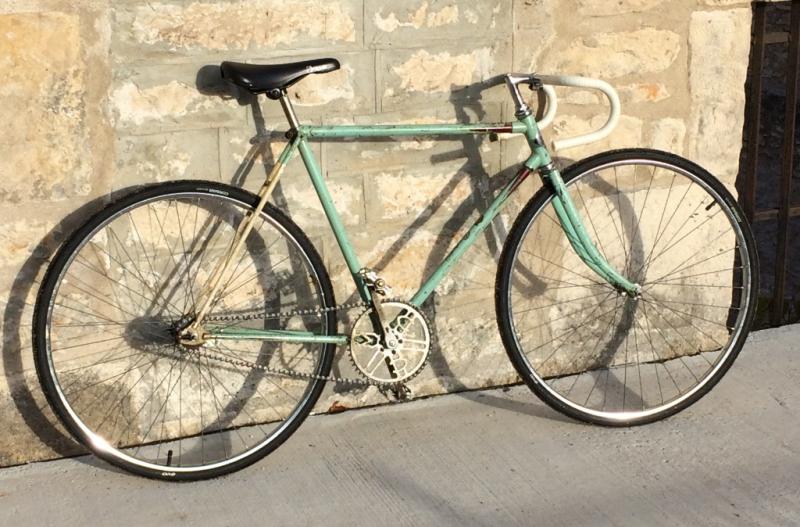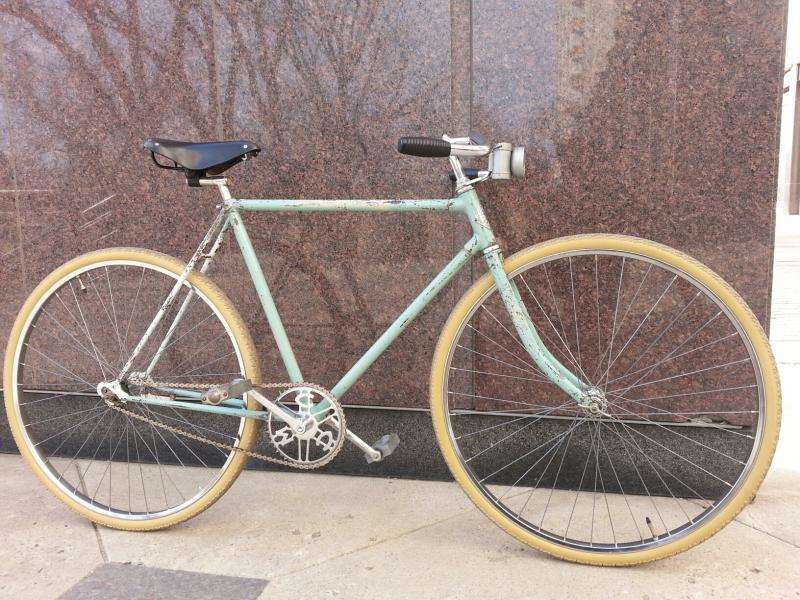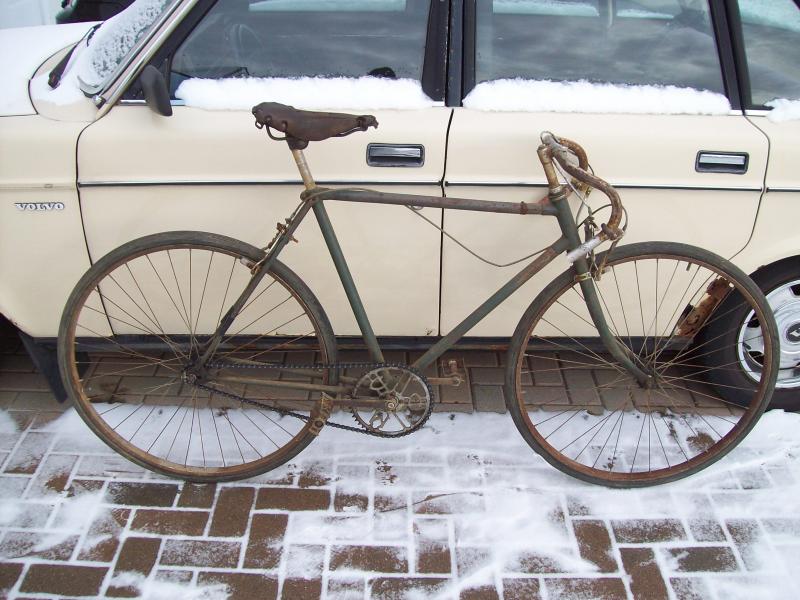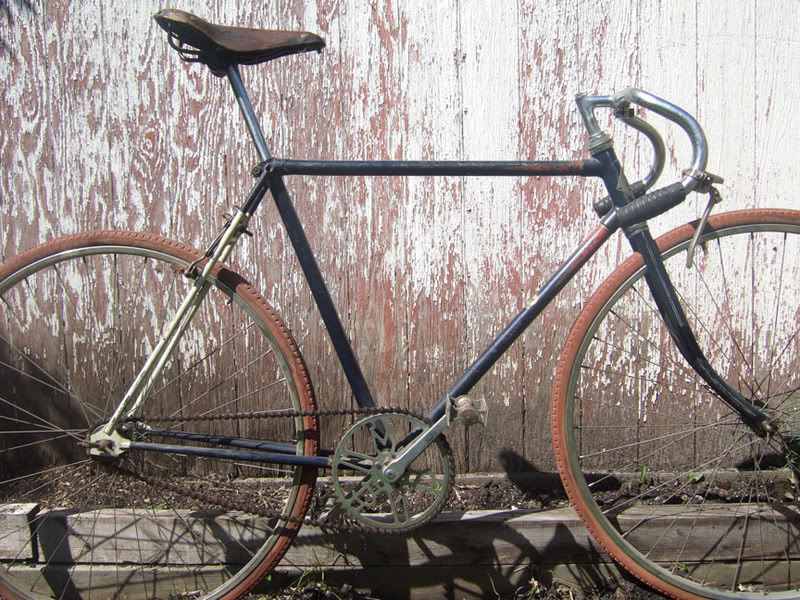Another Road Racer Question - Top Tube Angle
Hi All, sorry for being such a chatty Cathy but I have been working on the Road Racer and keep coming up with questions (some I already had the answer to ![]() )....
)....
In this case, the question is about top tube angle. As I understand things, the Road Racer only ever came in one frame size for men - 21". I have been gathering photos from the interwebs and noticed that some Road Racers have horizontal top tubes, but others (like mine) have a slight but distinct slope down towards the front wheel.
Why would there be differences (barring accident or other frame damage)?
Couple of examples: first mine (older shot and the effectis I think emphasized due to the camera, but still); other examples from various photos (and I apologize if I am using someone's picture without credit - can't recall where I found all of these images but if any belong to a forum member let me know either to credit you or to remove the image):









Road Racer Size also available depending on the year they were 22inch .
thanks
1934
Nice brochure, I have a 1936 roadracer and it looks the same as in the book.
Hello simonkarl what size is you frame
thanks GT
I’ll measure and find out
Are you guys suggesting that the difference top tube angle could be related to the frame size? Mine is a 21".
My main question was given that of the 4 pictures I posted, 2 have clearly horizontal top tubes and two have sloping top tubes....why do you think that would be? @simonkarl: the brochure shows a horizontal TT on the 36; is that the same on yours?
It's difficult to say for certian, without having one frame of each style on hand for measurement and comparison. However, it looks as if CCM tried to make two different size frames using the same length head tube. This would result in a sloping top tube on the larger frame size and also slightly steeper angles.
My understanding is that the Road Racer came in three frame sizes. Pre 1936, it was 22". Post 1936 it was 21". In 1936 it was offered in 21" & 23".
Mine is a horizontal top tube and measures 21 1/2”.
So it can't be frame size related, since mine is also 21" (21 1/2" ctt, 21" ctc), and my top tube drops about 1" towards the front. And @simonkarl's bike is only 2 years older than mine. I believe the last photo I posted with the horizontal top tube was captioned as a 1939, so one year newer than mine.
It probably doesn't matter but it simply strikes me as odd. Mine appears to have quite slack frame angles, which I expect in a bike from the 30s. I have also checked and there is no sign of damage at all so unlikely that the front was "raked out" causing the steerer tube to drop down (which is what I thought until I found the photo of the road racer above also with the slope in the top tube).
I’m missing one of the 5 bolts that connects chainring sprocket to crank arm, wondering if anybody has pares kicking around???
What's it look like ?Might have. Picture help.
It’s a 1936 roadracer, has ccm 5 bolt chain ring, flip flop rear hub. same as bikes mentioned above in this thread.
I have a bunch of small screws that are bike related but would need a picture of the screw and some measurement to help you.Is the head counter sunk? I don't have the road racer to check but a friend has a flyer that might take the same screws so I can check the size.
I’ll take pictures and measurements, does your friend happen to have some spare flyer rims without hubs??
I had a similar issue with missing chainwheel bolts on mine, and while I got some originals from a fellow enthusiast I did the measurements in case I couldn't find any replacements.
It appears an M5 0.8T/mm fits perfectly, and it should be simple to file a regular M5 cap bolt to have the thin square head of the original (its a 7mm square), and the nut is an M5 8mm head so again should be relatively common.
Its not clear if all 5 should have nuts on them or not - the chainring is also threaded. There are several lengths of original bolts - one length tightens up flush with no nut; one length is perfect for a nut to be tightened on the end. If you modify some modern bolts you can make up both and decide.
Yes the 4 I have are threaded through into the threaded chainring with no cap bolts on the other side. My flyer has small bolts on boTh sides of the chainring. If I can’t procure any I will try your advice thank you.
Here is what simonkarl is requiring yes I believe 5 nuts are required.
Gtflyte thank you for the pictures, that’s exactly what I’m after to get the roadracer back on the road.
I don't have that bolt. But should be easy to make with right thread and a file.
Here's a shot of my chainring setup. the two closest to the crank arm have no nut, the other three are nutted.
Given the era, the OEM bolts would have been imperial thread. M5 x 0.8 is almost exactly equivalent to 10-32UNF, so you could also search out machine screws and nuts in this thread standard. If you're attempting to modify the head to the OEM square style, I suggest paying a bit more for stainless steel machine screws, as it avoids the corrosion issue resulting from filing through the plating on standard steel fasteners.
Here is my spocket and bolt